
Dessert wines, sometimes called pudding wines in the United Kingdom, are sweet wines typically served with dessert.

Riesling is a white grape variety that originated in the Rhine region. Riesling is an aromatic grape variety displaying flowery, almost perfumed, aromas as well as high acidity. It is used to make dry, semi-sweet, sweet, and sparkling white wines. Riesling wines are usually varietally pure and are seldom oaked. As of 2004, Riesling was estimated to be the world's 20th most grown variety at 48,700 hectares, but in terms of importance for quality wines, it is usually included in the "top three" white wine varieties together with Chardonnay and Sauvignon blanc. Riesling is a variety that is highly "terroir-expressive", meaning that the character of Riesling wines is greatly influenced by the wine's place of origin.

Ice wine is a type of dessert wine produced from grapes that have been frozen while still on the vine. The sugars and other dissolved solids do not freeze, but the water does, allowing for a more concentrated grape juice to develop. The grapes' must is then pressed from the frozen grapes, resulting in a smaller amount of more concentrated, very sweet juice. With ice wines, the freezing happens before the fermentation, not afterwards. Unlike the grapes from which other dessert wines are made, such as Sauternes, Tokaji, or Trockenbeerenauslese, ice wine grapes should not be affected by Botrytis cinerea or noble rot, at least not to any great degree. Only healthy grapes keep in good shape until the opportunity arises for an ice wine harvest, which in extreme cases can occur after the New Year, on a northern hemisphere calendar. This gives ice wine its characteristic refreshing sweetness balanced by high acidity. When the grapes are free of Botrytis, they are said to come in "clean". This results in a very complex and sweet wine. Much ice wine is made from the grapes Riesling, Vidal, Cabernet Franc and Cabernet Sauvignon, but there is also ice wine made from Shiraz, Merlot, Sangiovese and others.
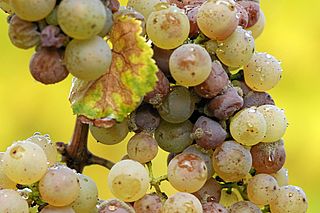
Noble rot is the beneficial form of a grey fungus, Botrytis cinerea, affecting wine grapes. Infestation by Botrytis requires moist conditions, but if the weather stays wet, the damaging form, "grey rot", can destroy crops of grapes. Grapes typically become infected with Botrytis when they are ripe. If they are then exposed to drier conditions and become partially raisined, this form of infection is known as noble rot. Grapes picked at a certain point during infestation can produce particularly fine and concentrated sweet wine. Wines produced by this method are known as botrytized wines.

Late harvest wine is wine made from grapes left on the vine longer than usual. Late harvest is usually an indication of a sweet dessert wine, such as late harvest Riesling. Late harvest grapes are often more similar to raisins, but have been naturally dehydrated while on the vine.

Trockenbeerenauslese, or TBA, is a German language wine term for a medium to full body dessert wine.

German wine is primarily produced in the west of Germany, along the river Rhine and its tributaries, with the oldest plantations going back to the Roman era. Approximately 60 percent of German wine is produced in the state of Rhineland-Palatinate, where 6 of the 13 regions (Anbaugebiete) for quality wine are situated. Germany has about 103,000 hectares of vineyard, which is around one tenth of the vineyard surface in Spain, France or Italy. The total wine production is usually around 10 million hectoliters annually, corresponding to 1.3 billion bottles, which places Germany as the eighth-largest wine-producing country in the world. White wine accounts for almost two thirds of the total production.

The German wine classification system puts a strong emphasis on standardization and factual completeness, and was first implemented by the German Wine Law of 1971. Nearly all of Germany's vineyards are delineated and registered as one of approximately 2,600 Einzellagen, and the produce from any vineyard can be used to make German wine at any quality level, as long as the must weight of the grapes reaches the designated minimum level. As the current German system does not classify vineyards by quality, the measure of wine ’quality’ is the ripeness of the grapes alone.
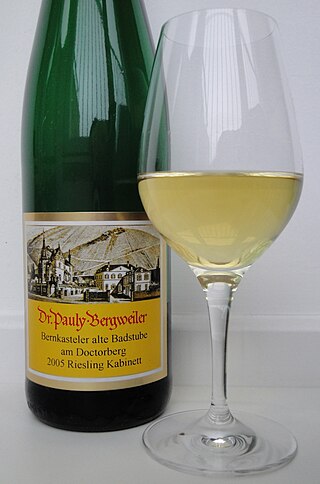
Kabinett, or sometimes Kabinettwein, is a German language wine term for a wine which is made from fully ripened grapes of the main harvest, typically picked in September, and are usually made in a light style. In the German wine classification system, Kabinett is the lowest level of Prädikatswein, lower in ripeness than Spätlese.

Spätlese is a German wine term for a wine from fully ripe grapes, the lightest of the late harvest wines. Spätlese is a riper category than Kabinett in the Prädikatswein category of the German wine classification and is the lowest level of Prädikatswein in Austria, where Kabinett is classified in another way. In both cases, Spätlese is below Auslese in terms of ripeness. The grapes are picked at least seven days after normal harvest, so they are riper and have a higher sugar content. Because of the weather, waiting to pick the grapes later carries a risk of the crop being ruined by rain. However, in warm years and from good sites much of the harvest will reach Spätlese level.
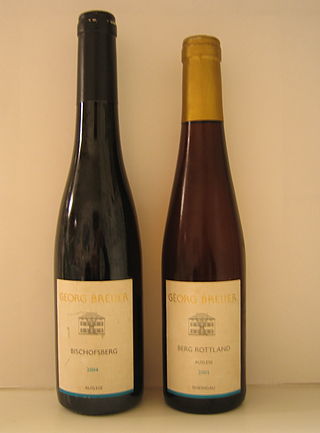
Auslese is a German language wine term for a late harvest wine and is a riper category than Spätlese in the Prädikatswein category of the Austrian and German wine classification. The grapes are picked from selected very ripe bunches in the autumn, and have to be hand-picked. Generally Auslese wine can be made in only the best harvest years that have been sufficiently warm. A small proportion of the grapes may be affected by noble rot in some regions although this never dominates the character of the wine. Rheingau winemaker Schloss Johannisberg is generally credited with discovering Auslese wine in 1787.
Trocken, German for dry, is a classification of German wine that indicates a wine that is dry rather than off-dry (halbtrocken), sweeter (lieblich) or sweet (süß). Trocken wines are not devoid of residual sugar, but have, at most, a few grams per liter, which can be perceptible but is not overtly sweet. Trocken is also a designation for Austrian wine, but more rarely used there than in Germany, since many quality categories of Austrian wines are dry by default.
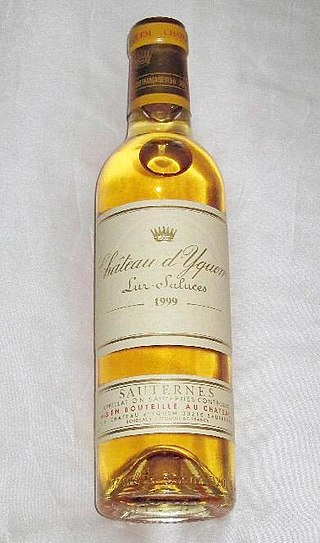
The subjective sweetness of a wine is determined by the interaction of several factors, including the amount of sugar in the wine, but also the relative levels of alcohol, acids, and tannins. Sugars and alcohol enhance a wine's sweetness, while acids cause sourness and bitter tannins cause bitterness. These principles are outlined in the 1987 work by Émile Peynaud, The Taste of Wine.
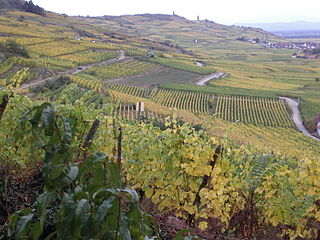
Alsace wine or Alsatian wine is produced in the Alsace region in France and is primarily white wine. Because of its Germanic influence, it is the only Appellation d'Origine Contrôlée region in France to produce mostly varietal wines, typically from similar grape varieties to those used in German wine. Along with Austria and Germany, it produces some of the most noted dry Rieslings in the world as well as highly aromatic Gewürztraminer wines. Wines are produced under three different AOCs: Alsace AOC for white, rosé and red wines, Alsace Grand Cru AOC for white wines from certain classified vineyards and Crémant d'Alsace AOC for sparkling wines. Both dry and sweet white wines are produced.

Vendange tardive ("VT") means "late harvest" in French. The phrase refers to a style of dessert wine where the grapes are allowed to hang on the vine until they start to dehydrate. This process, called passerillage, concentrates the sugars in the juice and changes the flavours within it. The name is sometimes written as the plural form, vendanges tardives, referring to the fact that several runs through the vineyard are often necessary to produce such wines. In other countries such as Germany or Austria the term Spätlese is used to describe wine using the same making process.
The Oechsle scale is a hydrometer scale measuring the density of grape must, which is an indication of grape ripeness and sugar content used in wine-making. It is named for Ferdinand Oechsle (1774–1852) and it is widely used in the German, Swiss and Luxembourgish wine-making industries. On the Oechsle scale, one degree Oechsle (°Oe) corresponds to one gram of the difference between the mass of one litre of must at 20 °C and 1 kg. For example, must with a specific mass of 1084 grams per litre has 84 °Oe.
Sélection de Grains Nobles (SGN) is French for "selection of noble berries" and refers to wines made from grapes affected by noble rot. SGN wines are sweet dessert wines with rich, concentrated flavours. Alsace wines were the first to be described as Sélection de Grains Nobles, with the legal definition introduced in 1984, but the term is also seen in some other wine regions France, such as Loire.
Ausbruch or sometimes Ausbruchwein is an Austrian wine term for a quality level in the Prädikatswein category. It is situated between Beerenauslese and Trockenbeerenauslese in requirements, which makes it a sweet dessert wine typically made from grapes affected by noble rot. The minimum must weight requirements for Ausbruch is 30 degrees KMW. The Ausbruch Prädikat exists only in Austria and Hungary, not in Germany. The category was introduced into Austrian wine legislation in 1970, as a legalization of the production method allegedly already used in the area of Rust. Ruster Ausbruch are still the most common Ausbruch wines to encounter; in many other Austrian regions, producers classify their wines as Beerenauslese if they fall short of the Trockenbeerenauslese requirements. Since October 2020, the Ruster Ausbruch is legally protected by the Austrian DAC system of origins as "Ruster Ausbruch DAC".

Coteaux du Layon is an Appellation d'origine contrôlée (AOC) for sweet white wine in the Loire Valley wine region of France. Coteaux du Layon is situated in the Anjou district of the region, along the river Layon, which is a tributary of the Loire. Six of the villages (communes), namely Beaulieu-sur-Layon, Faye-d'Anjou, Rablay-sur-Layon, Rochefort-sur-Loire, Saint-Aubin-de-Luigné and Saint-Lambert-du-Lattay are allowed to add their name to that of the appellation. Usually, the "de" or "sur" part is dropped, to give names like Coteaux du Layon Beaulieu and Coteaux du Layon Saint-Aubin. Furthermore, two villages within the Coteaux du Layon area form their own respective AOC – Bonnezeaux and Chaume. Finally, a favoured enclave within Chaume is a separate AOC under the name Quarts de Chaume. For the geographically delimited AOCs, required grape maturity is higher and allowed yield is lower. The best vineyards are generally located on the north bank of the Layon, where they enjoy a good sun exposure on roughly south-facing slopes. Coteaux du Layon including its enclave appellations cover about 1,400 hectares in the early 2000s.
The 1985 Austrian diethylene glycol wine scandal was an incident in which several Austrian wineries illegally adulterated their wines using the toxic substance diethylene glycol to make the wines appear sweeter and more full-bodied in the style of late harvest wines. Many of these Austrian wines were exported to West Germany, some of them in bulk to be bottled at large-scale West German bottling facilities. At these facilities, some Austrian wines were illegally blended into German wines by the importers, resulting in diethylene glycol ending up in some bulk-bottled West German wines as well.














